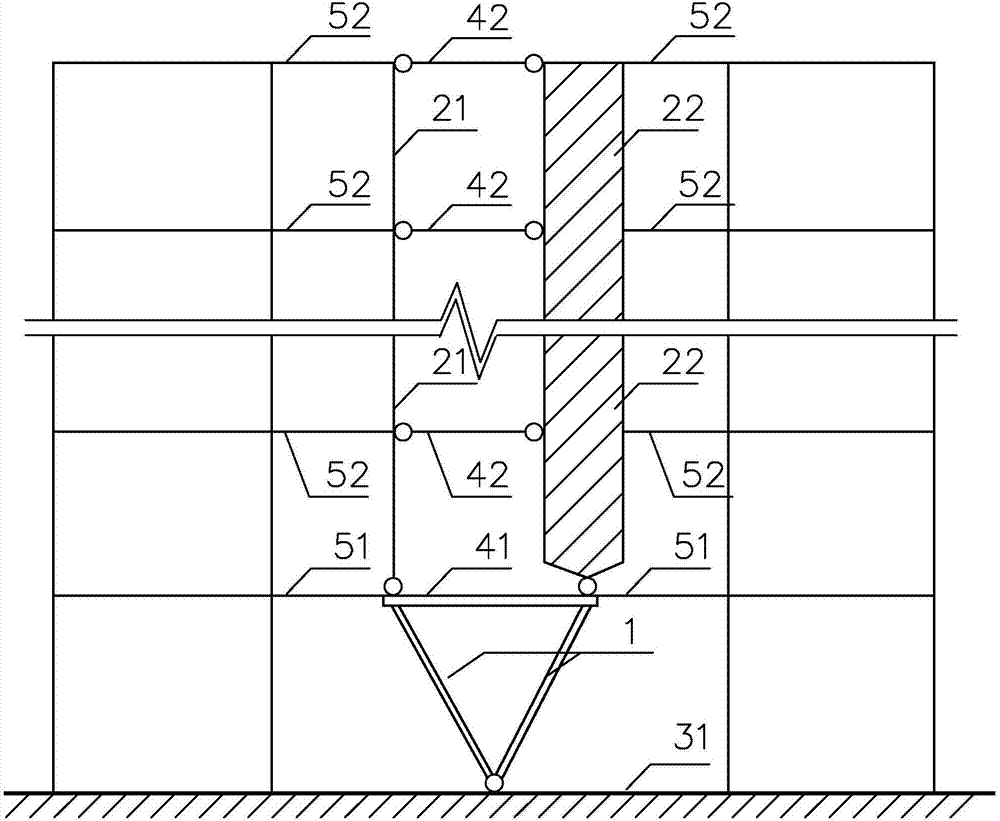Shaking type self vibration reducing structure
A swaying, self-attenuating technology, which is applied to building components, protective buildings/shelters, and earthquake resistance, can solve problems such as large earthquake deformation, and achieve the effect of reducing horizontal vibration and reducing adverse effects
- Summary
- Abstract
- Description
- Claims
- Application Information
AI Technical Summary
Problems solved by technology
Method used
Image
Examples
Embodiment 1
[0026] See figure 1 , figure 2 As shown, in a swaying self-damping structure of the present invention, a swaying member is partially arranged at the bottom of the structure, and the left and right parts of the swaying member respectively support the upper support column 21 and the wall 22 . The components (support columns or walls) supported by the left and right parts of the swing member are not the same component. In this embodiment, the left part of the swing component supports the support column 21, and the right part of the swing component supports the wall 22. The rocking member is supported on the top of the foundation 31, which weakens the rigidity of the floor of the structure (that is, the floor where the rocking member is located) and forms a system that can locally shake. When encountering an earthquake, the rocking member is pushed by the surrounding structures to swing back and forth, and the supporting column 21 and the wall 22 supported by the left and right ...
Embodiment 2
[0040] See image 3 As shown, a swaying self-damping structure of the present invention is mainly different from Embodiment 1 in that: the lower end of the V-shaped column 1 is rigidly connected to the top of the foundation 31, and the members supported by the two upper ends of the V-shaped column 1 are respectively It is the support column 21, 23, and the connection with the support column 21, 23 is a rigid connection, and the connection between the support column 21, 23 and each fourth beam 42 between them is a rigid connection.
[0041] When the system encounters an earthquake, because the V-shaped column 1 rotates around its lower end, and the supporting columns 21, 23 on its two upper ends are involved in sideways movement and relative movement up and down, the lower end of the V-shaped column, the two upper ends of the V-shaped column and the The joints of the supporting columns 21, 23, and the beam sections at the joints of the supporting columns 21, 23 and the fourth bea...
Embodiment 3
[0043] See Figure 4 As shown, a kind of swaying self-damping structure of the present invention, its main difference with embodiment two is: the lower end of V-shaped column 1 is supported on the top of beam 32 on a higher floor, and the lower end of V-shaped column 1 is connected to the floor beam The mechanical model of the connection of the 32 roof is a hinge, and the mechanical model of the connection between the upper ends of the V-shaped column 1 and the supporting columns 21, 23 is a hinge.
[0044] The left part and the right part of the rocking member refer to two parts where the rocking member is located in the lateral direction of the self-vibration-damping structure, and the two parts are separated by the position where the rocking member is supported on the floor beam 32 .
PUM
 Login to View More
Login to View More Abstract
Description
Claims
Application Information
 Login to View More
Login to View More - R&D
- Intellectual Property
- Life Sciences
- Materials
- Tech Scout
- Unparalleled Data Quality
- Higher Quality Content
- 60% Fewer Hallucinations
Browse by: Latest US Patents, China's latest patents, Technical Efficacy Thesaurus, Application Domain, Technology Topic, Popular Technical Reports.
© 2025 PatSnap. All rights reserved.Legal|Privacy policy|Modern Slavery Act Transparency Statement|Sitemap|About US| Contact US: help@patsnap.com



